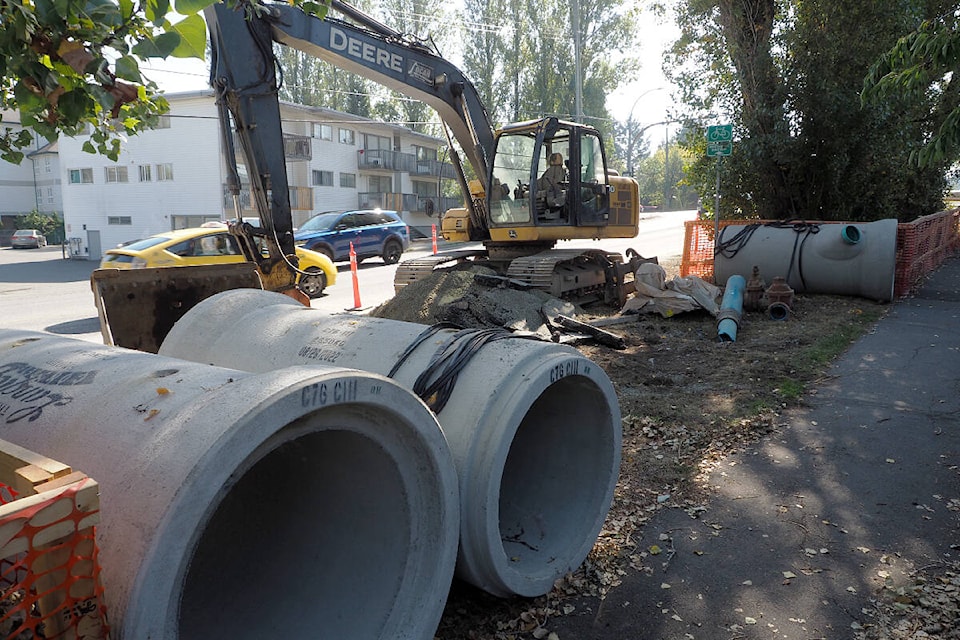Nanaimo is growing so fast it’s becoming more difficult financially to have new sewers in place to keep up.
Nanaimo city councillors, at a finance and audit meeting Wednesday, Sept. 13, were advised that the city’s ability to keep up with building new sewers risks being overwhelmed by the slow pace of replenishing funding through development cost charges.
Bill Sims, the city’s general manager of engineering and public works, was the bearer of the bad news at the meeting, introducing a staff report from Poul Rosen, director of engineering, and Laura Mercer, director of finance. Since 2018, 15 sewer DCC projects were completed, totalling five kilometres of upgraded infrastructure valued at approximately $14.3 million, but rapid growth – Sims described it as “explosive” – in many areas means more upgrades beyond those already completed are required and the rate of funding isn’t keeping pace with the need to build more projects more quickly.
“Generally, you want to have projects built before you start flushing toilets,” Sims said.
DCCs – development cost charges – are collected from land developers to offset the costs of building infrastructure to service new developments. DCCs are collected and deposited into separate accounts so there is money set aside to pay for development or expansion of facilities and infrastructure, such as roads, parks, water distribution and sanitary sewer systems.
“Typically, over a 25-year life you identify projects that you would build and fund over that 25 years,” Sims said. “That works well in theory, but in practice, as we’ve seen rapid growth in the last five years … we’re running around, running back and forth, to keep up with the growth and keep ahead of the growth. That’s created a pinch for funding.”
According to the report, about $13.2 million worth of sewer DCC projects are proposed over the coming five years, a cost similar to projects for the previous five years, but inflation will make fewer projects possible for that same level of available funding. An additional $16 million worth of sewer upgrades would also ideally be included in the next five year plan. Those projects aren’t yet funded and not doing them could translate to sewer backups.
Sims said there are a number of strategies staff could take to “ease some of the short-term pain.” In the past, money could be borrowed from other DCC accounts to cover funding shortfalls for high-priority new sewerage infrastructure projects.
“It’s now to the point where the cost of borrowing is exceeding the revenue stream from DCCs to the ‘sewer pot’ so that becomes no longer viable,” Sims said.
Another option, he said, is to use sanitary system user rates to pull in project revenue, but that creates a burden on existing users to pay for future growth. Sims said when Nanaimo’s DCC bylaw is reviewed and updated, likely next year, staff will look for a way out of the funding crunch. In the meantime, engineering and public works is monitoring the system to make sure it isn’t running a risk of overflow.
“But as you know, the city’s so spread out, the sewer system is so spread out, it’s hard to balance priorities,” he said.
Sims said concentrating development into urban nodes, as per the city plan, to limit urban sprawl and try to not allow development where there isn’t capacity to service it, could mitigate the issue in the future.
Nanaimo doesn’t have a history of significant sewer overflows, the report notes, but there are locations or bottlenecks in the system that are at risk during storms. There was also a period in the 1990s, Sims recalled, when the Millstone Trunk sewer faced capacity issues and there was a moratorium on development in its catchment area for a period of time until it could be upgraded.
“I think part of putting this report out there is to just raise the awareness and not get to that point,” he said. “We don’t want to [reach] a point where we’re denying occupancy permits because residents can’t flush their toilets … We don’t want to limit opportunities for housing and growth and development. That’s critical, so we want to try and keep ahead of this.”
Nanaimo Mayor Leonard Krog said there is a consequence to the city’s population growth and called the report a “fair warning” about future growth and cost of that growth.
“I know that the business community and the development community will be disturbed by this because the whole question of DCCs is always a controversial topic,” the mayor said.
chris.bush@nanaimobulletin.com
Like us on Facebook and follow us on Twitter
